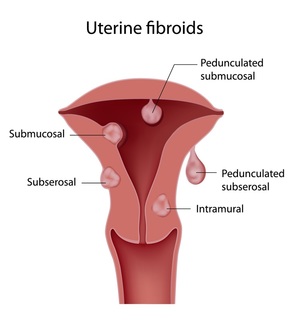Uterine Fibroids

Uterine fibroids (also known as leiomyomas or myomas) are bundles of smooth muscle and connective tissue that can be as small as a pea or as large as a grapefruit. Uterine fibroids are typically slow-growing and non-cancerous. Around 30% of women over age 30 have at least one fibroid. Hysterectomies due to fibroids are the most common major surgery in women.
Uterine fibroids are classified according to their location, as follows:
• Submucosal (just under the lining of the uterus)
• Intramural (within the uterine muscle wall)
• Subserosal (just inside the outer wall of the uterus)
• Interligamentous (in the cervix between the two layers of the broad ligament)
• Pedunculated (on a stalk, either submucosal or subserous)
Symptoms
Causes
The cause is unknown but research point to complex interactions between estrogen, progesterone, and local growth factors that contribute to the growth of fibroids.
If you are experiencing any of the symptoms above, please contact Dr. Linda Gedeon for proper evaluation and to discuss the best treatment options for you.
Uterine fibroids are classified according to their location, as follows:
• Submucosal (just under the lining of the uterus)
• Intramural (within the uterine muscle wall)
• Subserosal (just inside the outer wall of the uterus)
• Interligamentous (in the cervix between the two layers of the broad ligament)
• Pedunculated (on a stalk, either submucosal or subserous)
Symptoms
- Prolonged menstrual periods (7 days or longer)
- Heavy menstrual bleeding
- Bloating or fullness in the belly or pelvis
- Pain in the lower belly or pelvis
- Constipation
- Frequent urination
- Pain with intercourse
- Difficulty emptying your bladder
- Anemia due to increased blood loss
Causes
The cause is unknown but research point to complex interactions between estrogen, progesterone, and local growth factors that contribute to the growth of fibroids.
If you are experiencing any of the symptoms above, please contact Dr. Linda Gedeon for proper evaluation and to discuss the best treatment options for you.

